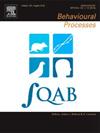More complex anti-predator behaviors develop with age in Chinese water deer fawns
IF 1.3
4区 生物学
Q4 BEHAVIORAL SCIENCES
引用次数: 0
Abstract
An anti-predator strategy increases the fitness of the prey itself, in which vigilance behavior plays an important role. Numerous studies have explored the correlation between prey age and the level of vigilance towards an approaching predator. However, limited studies have delved into the development of vigilant behaviors, much less the vigilant decision-chains. Chinese water deer (Hydropotes inermis), an extremely timid and sensitive animal capable of independent movement at birth, exhibits changes in vigilance strategy from newborn to the end of suckling period. Through individual recognition and standardized flight initiation trial, we measured the distances between the approaching predator and the occurrence of various vigilance behaviors (stare, flight, roaring, stretching neck, vigilant stomping). Our results reveal that Chinese water deer exhibited the vigilant strategy of roaring in the early stage (<3 weeks), and stretching neck and vigilant stomping in the late stage (≥10 weeks), displaying an overall trend of increasing complexity. The vigilant decision-chains of the fawns become more diverse with age. Fawns prioritize their own intrinsic status when making flight decisions under the same threat, with age, birth weight, and pre-flight behaviors emerging as the dominant determinants. Overall, our findings indicate that suckling fawns of Chinese water deer adopt different vigilance behavioral strategies with their development and depending on their age, birth weight and pre-flight behaviors when faced with a threat.
中华水鹿幼鹿的反捕食行为随着年龄的增长而发展
反捕食者策略提高了猎物自身的适应性,其中警惕行为起着重要作用。许多研究探索了猎物年龄与对接近的捕食者的警惕程度之间的关系。然而,对警惕行为发展的研究有限,更不用说警惕决策链了。中华鹿(Hydropotes inermis)是一种极其胆小和敏感的动物,出生时能够独立运动,从新生到哺乳结束,警觉策略发生了变化。通过个体识别和标准化的飞行起始试验,我们测量了接近捕食者与发生各种警戒行为(凝视、飞行、咆哮、伸长脖子、警惕跺脚)的距离。结果表明,中国水鹿在早期(3周)表现出吼叫的警戒策略,在后期(≥10周)表现出伸长脖子和警戒踩踏的策略,总体上呈现出复杂性增加的趋势。随着年龄的增长,小鹿警觉的决策链变得更加多样化。当小鹿在同样的威胁下做出飞行决定时,它们会优先考虑自己的内在状态,年龄、出生体重和飞行前的行为是主要的决定因素。综上所述,中国水鹿的哺乳小鹿在面对威胁时会采取不同的警惕行为策略,这取决于它们的年龄、出生体重和飞行前行为。
本文章由计算机程序翻译,如有差异,请以英文原文为准。
求助全文
约1分钟内获得全文
求助全文
来源期刊

Behavioural Processes
生物-动物学
CiteScore
2.70
自引率
7.70%
发文量
144
审稿时长
4-8 weeks
期刊介绍:
Behavioural Processes is dedicated to the publication of high-quality original research on animal behaviour from any theoretical perspective. It welcomes contributions that consider animal behaviour from behavioural analytic, cognitive, ethological, ecological and evolutionary points of view. This list is not intended to be exhaustive, and papers that integrate theory and methodology across disciplines are particularly welcome.
 求助内容:
求助内容: 应助结果提醒方式:
应助结果提醒方式:


